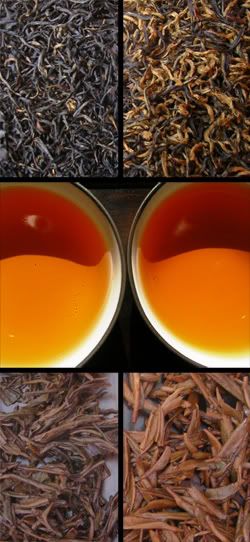Caledonian Springs @ 100C in 10cl daoba xishi, used for hongcha; ~5g leaf; 1 rinse; teas tasted sequentially
Dry leaves:
2000: not the best grade, as many smaller leaves are evident. The best grades of hongcha have bigger, furry tips, while the lower grades are mixed with tiny, darker non-tip leaves. This is the reverse of many other tea grades, in which smaller leaves are generally taken as higher grades. In the case of this 2000, the tips have turned black. Malty aroma of old grapes.
2007: yellow and black, a higher grade. Fresh, red aroma.
 12s, 16s, 32s:
12s, 16s, 32s:2000: The aroma is dark, husky, and long - giving a good sign of longevity for the tea, which is orange with a red hint. Very smooth in texture, but not the extraordinary silk of the 2006 Premium Gold-Tips Dianhong from Yunnan Sourcing, provided by CB.
The malty flavour is refreshing, and fairly long in patience for a hongcha. This Fujian variety is higher and sweeter than some other provinces, ending in the sweetness of old honey and treacle. There is a little hongcha sourness, but the edge has been eroded over the years. Delicious.
2007: Currant-like, reminding me of the 2006 Xinzhu County Oriental Beauty from Teamasters. A quick change into a sour lengxiang makes this a fairly acrobatic tea in the wenxiangbei. Yellower soup than its cousin, which stabilises to become identical in the second infusion [pictured].
A touch simpler in flavour, with a tendency towards the currant-bun noted in the aroma. It's a touch more sour, and not quite as delectably sweet as the 2000.
Wet leaves:
2000: ubiquitously dark, with some stems and broken leaves indicating its lower grade.
2007: plush, full, bulging pea-pod like tips, which are classically red.
Overall:
It's an interesting experiment to compare two similar teas (if of slightly differing grade) with considerably different maturity.
Received wisdom places hongcha at its best at, or after, one year of aging - authority seems divided. Experience from this tasting indicates that the 7-year-old is smoother, more well-integrated, and exhibits sufficient endurance to make limited aging a worth-while prospect. The 2000 is clearly the better tea, despite its lower grade of content.

2 comments:
Hi DC! I went to a BBQ picnic yesterday (Sunday) and brought with me my gongfu tea set. Later towards the evening in the park, some of my best friends gathered round me and we tasted a few teas, one of which was the 2007 Organic Dian Hong that you kindly sent to me (along with many other teas). Thank you.
I've never had a Dian Hong before and so I didn't know what to expect. Such high grade tea leaves! Entirely made of red-colored tippy buds. It's bold, as red teas are, and assertive in nose, taste and texture.
Some of the aroma characteristics did remind me of Oriental Beauty from Teamasters, though unlike the OB, this Dian Hong was very astringent througout the mouth...like drinking a much too young cabernet sauv. in texture. I like your "currant" characterization, and I agree.
Also, the tea was very frothy throughout the many infusions. Did you remember it as such when brewing yours?
I used a 175ml gaiwan, just-boiled water, starting with a 7 sec first infusion.
Thanks for the tea! I will proceed with the others momentarily.
Rgds,
A
G'day sir!
Thanks very much for posting your experience, I'm very glad that you enjoyed it - and am even more happy that you enjoyed it in good company!
Toodlepip,
Hobbes
Post a Comment